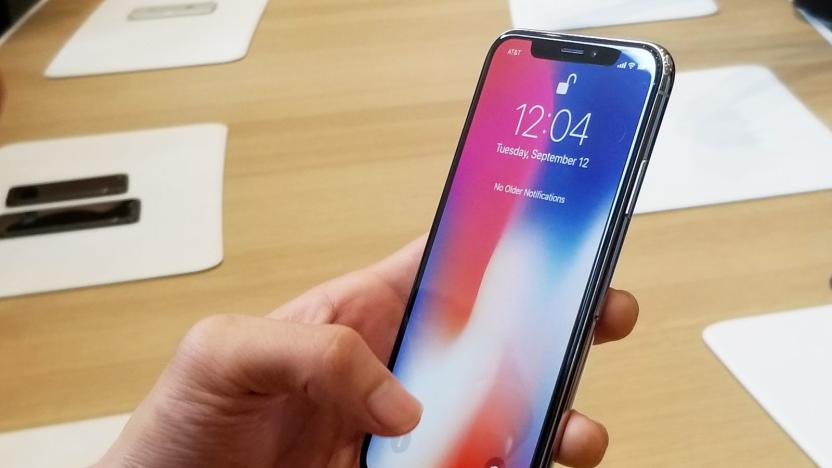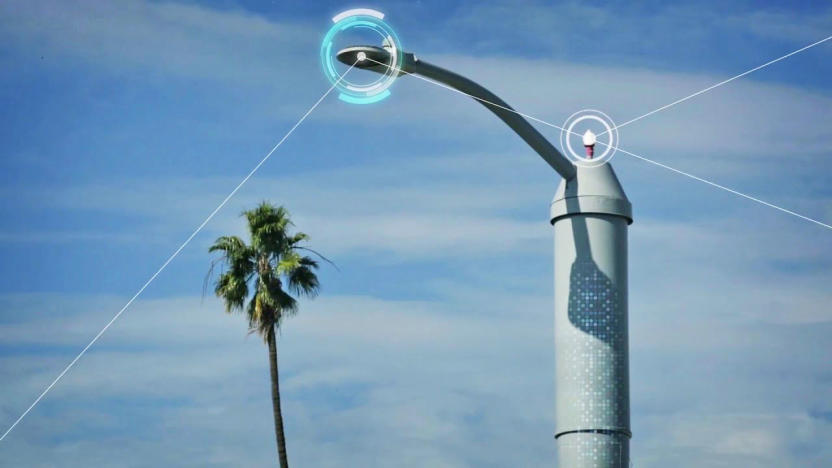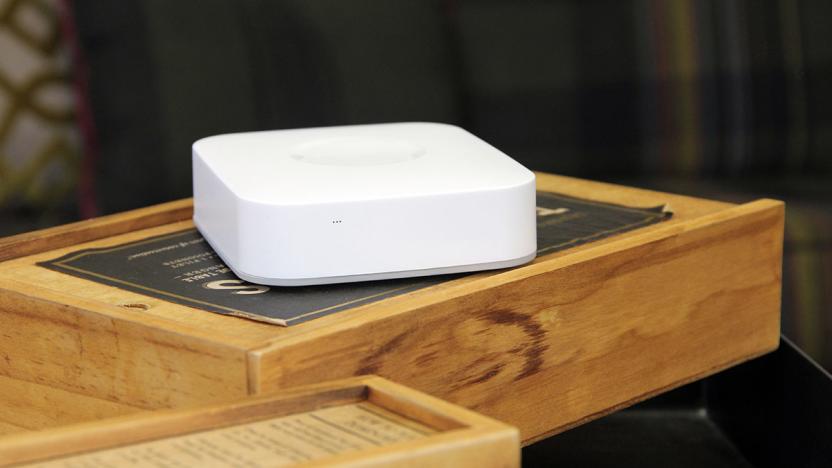sensors
Latest

Court rules Zepp has to stop selling its baseball and softball sensors
Zepp Labs' sensors let you analyze your performance across a number of sports, including baseball, softball, golf, tennis and soccer. But some of its performance-tracking products will soon be no more. In 2015, Blast Motion, a company that makes similar products, sued Zepp for patent infringement and today the two companies announce that they've reached a settlement.

Apple denies reports that it altered Face ID specs (update)
Ever since the iPhone X was announced, there's been rumors that the handset will be a rarer commodity than gold dust and the Venus de Milo's arms, combined. That's because the components used to build the device's facial-recognition sensor are so complex that it's been nearly impossible to mass-produce. Now, a report from Bloomberg suggests that Apple has found a solution by "relaxing" the specifications for FaceID.

Acoustic gunshot sensors help speed treatment of shooting victims
Acoustic gunshot sensors have been pinpointing shooting scenes and victims for years. The tech can be found in around 90 US cities in total. Meanwhile, the American military has been using it to track down the source of gunshots on the battlefield since 2011. But, the effectiveness of the sensors in saving the lives of ordinary citizens has never been quantified. That's all changing, courtesy of a new study by surgeons at the University of California, San Francisco-East Bay. The key finding from the analysis of shooting victims (identified through the sensors) is that the tech is potentially beneficial for those who have suffered serious injuries.

Networked self-driving cars are smarter and safer
You know what's better than one self-driving car on the road? Two, because then they can pool resources. Vehicle-to-vehicle (V2V) communication isn't anything new, of course, but researchers at Switzerland's federal institute of technology, EPFL, are taking things one step further. By wirelessly connecting the LIDAR, sensors and navigation systems of two cars in convoy, both can get a fuller picture of the world around them.

Your phone's motion sensors can give away PINs and passwords
You could be the most careful mobile user ever, but hackers can still steal your PINs and passwords simply by spying on your phone's motion sensors. A team of cyber researchers from the UK's Newcastle University have demonstrated how easy it is to steal a four-digit PIN by analyzing the way your phone tilts and moves as you type. You might think your phone's movements are random, but they apparently create distinct patterns. During their tests, they were able to crack four-digit PINs on the first guess 70 percent of the time and 100 percent of the PINs they used by the fifth guess.

AT&T's smart streetlights can smooth traffic, detect gunshots
AT&T first unveiled its ambitious "Smart Cities" program at CES 2017 in Las Vegas, but now we have an idea as to how it's going to work. The telecom has signed a deal with GE to install its Current CityIQ sensors into streetlights in various cities and municipalities around the US, starting with San Diego. The aim is to not just provide more intelligent lighting, but also monitor things like traffic circulation, parking spots, air quality, weather emergencies and even gunshots

These connected shoes could help you run faster, smarter and more safely
Power laces and 3D-printed materials aren't the only things shaping the future of footwear. If Sensoria and Vivobarefoot have their way, people could soon be wearing shoes packed with tech to help them run faster, smarter and more safely. Here at CES, the companies revealed a pair of concept sneakers that feature two removable chips and four pressure sensors near the heel area. Not only can the system measure speed, pace and track you via GPS, but it's also smart enough to learn your stride rate and foot-landing technique.

Qualcomm wants to make smarter cars by sharing sensor data
You don't need us to tell you that modern cars aren't just cars. They're places to surf the web and watch movies, and they're getting smarter by the day. With the launch of its new Drive Data platform, Qualcomm is trying to add another big role to that list. As far as the company is concerned, modern cars are roving sensors too, and there's a lot to be done with all the data they collect.

Here and MobilEye team up on self-driving tech for automakers
There are so many companies working on autonomous car tech that we're now seeing the inevitable next phase: partnerships and consolidation. Case in point is a tie-up between MobilEye, the sensor maker that supplied sensors to Tesla before a messy split, and Here, the mapmaker Nokia recently sold to a German automaker consortium. The idea is to package Here's HD Live mapping software with MobilEye's hardware and sell it as a third-party automated platform to any interested car manufacturers.

Tiny body-roaming robots could be the future of wearables
Wearables have gotten smaller and less obtrusive over the years, culminating in today's compact fitness trackers and smartwatches that stay immobile and out of the way. But that doesn't have to be the case. Researchers at MIT and Stanford teamed up to develop Rovables, miniature robots chock full of sensors that roam around the human body while the wearer goes about their lives.

Tesla may have disabled the Model X's door safety sensors
The latest firmware Tesla rolled out for Model X was supposed to fix its buggy doors, but it seemed to have brought new problems of its own. See, the car's sweet Falcon doors had been giving owners grief. One common complaint was that their inductive sensors, in charge of preventing those automatic wings from crushing precious fingers, were inclined to detect objects that weren't really there. Owners would sometimes have to try a few times to get them to close. According to the new firmware's logs, the update is supposed to improve this behavior. However, based on the tests conducted by MEtv Product Reviews on YouTube, Tesla might have deactivated those sensors altogether instead of issuing a proper fix.

The 3D-printed eggs that could save vultures from extinction
It's hard to drum up sympathy for vultures. They do, after all, feast on the carcasses of dead (and diseased) animals. But at the International Centre for Birds of Prey in the UK, conservationists are hoping to keep extinction at bay for one African species by 3D printing vulture eggs. The replicas, which are made to simulate the same shape, weight and feel of actual vulture eggs, pack sensors inside (kinda like a Kinder surprise egg, except not at all) to gather data on the complicated incubation process. Wired reports that researchers at the ICBP have already begun testing these faux eggs on captive vultures to cull temperature, humidity, barometric pressure, carbon dioxide, light and rotation data -- all transmitted wirelessly -- for its captive breeding program.

Hive begins selling its smart plug and connected home sensors
When British Gas subsidiary Hive unveiled its latest take on the smart thermostat, the company also committed to launching a new a range of motion sensors, lightbulbs and a smart plug. It's taken six months, but Hive is finally ready to add its Active Plug and Window and Door sensors to its connected home line-up, with all three products now available to buy online.

ICYMI: Aging exoskeleton suit, the biometric bed and more
#fivemin-widget-blogsmith-image-726881{display:none;} .cke_show_borders #fivemin-widget-blogsmith-image-726881, #postcontentcontainer #fivemin-widget-blogsmith-image-726881{width:570px;display:block;} Today on In Case You Missed It: Applied Minds built an exoskeleton suit for insurance company Genworth and took it on the road to CES to give conference goers a dose of empathy for the elderly. The suit reenacts the physical ailments people often suffer as they age, from vision loss to hearing problems.

Stretchable square of rubber doubles as a keyboard
There's a whole branch of science that's dedicated to turning flexible surfaces into sensors that can be used as an artificial substitute for skin. These materials could then be used to give robots a sense of touch, or even to restore feeling for people with artificial prostheses. Researchers at the University of Auckland have taken the concept in a slightly different direction after building a square of soft, stretchable rubber that pulls double-duty as a keyboard. It's hoped that the technology can be used to create foldable, rollable input devices, which reminds us of Nokia's twisty-stretchy phone concept from way back when.

MIT researchers develop ingestible sensor to measure vital signs
Stethoscopes listen to your body. These acoustic devices have been around since the 19th century and are still the norm for auscultating or examining the internal sounds of your body. But a team of researchers at MIT have developed an ingestible sensor that could measure your vital signs from the inside, specifically from the gastrointestinal tract. The new sensor, packaged inside a silicone capsule that's the size of an almond, is expected to make both short and long term assessments easier on patients. Beyond hospitals, it could also help monitor soldiers and assist athletic training programs.

Sony's lucrative image sensor division is now a separate company
Sony is transforming one of its most successful businesses, image sensors, into a brand new company called Sony Semiconductor Solutions. All of its chips will be produced under the new company, but Sony said in a statement that "image sensors are a primary area of focus." The division will be carved away from Sony's devices group as part of a larger reorganization, and the rest of the group (storage and batteries) will be folded into other operations. Sony emphasized that the new company will operate "alongside existing Sony group companies," and start operating by April 1, 2016.

Samsung's next-gen SmartThings home hub goes on sale
The next generation of SmartThings hardware is now available after a lengthy delay. Samsung purchased the home automation company just over a year ago, but was optimistic when it said the next-gen hardware would arrive in April. The hub, sensors and app (available on iOS and Android) are now good to go, however, along with developer tools to get other companies on board. The new hub improves on the last version in a couple of key ways. It no longer needs an internet cloud connection to function, and can run autonomously for 10 hours on a battery if the power is cut.

Google's testing pollution-sensing gear in its Street View cars
A firm that builds environmental sensors is teaming up with Google to turn Street View cars into mobile pollution sniffers. Three of the search engine's mapping vehicles have been equipped with hardware to measure harmful compounds in the atmosphere including carbon monoxide, methane and VOCs. It's early days, but it's hoped that Google will be able to add this information to its maps, enabling people to see detailed air quality reports for their neighborhood. That way, you could plan your next jog to avoid trouble spots and authorities can visualize where they need to direct their clean-up efforts.

Meet Hive's gorgeous new thermostat and smart home devices
Google's Nest, Honeywell, Netatmo, Tado and others have made heating our abodes that bit simpler, but a smart thermostat does not a smart home make. British Gas' Hive launched its take on the smart thermostat two years ago -- and now, 200,000 installs later, it's time for a sequel. This time around, though, Hive doesn't just want to make your heating smarter, but the rest of your home as well. In addition to its brand-new £249 thermostat, the Hive brand will include soon smart plugs, a whole host of motion sensors and eventually, lightbulbs too.











